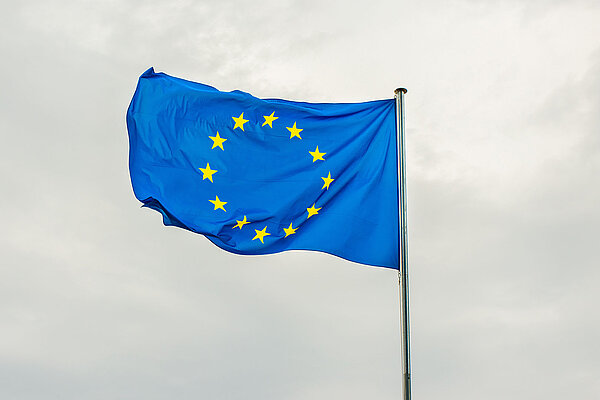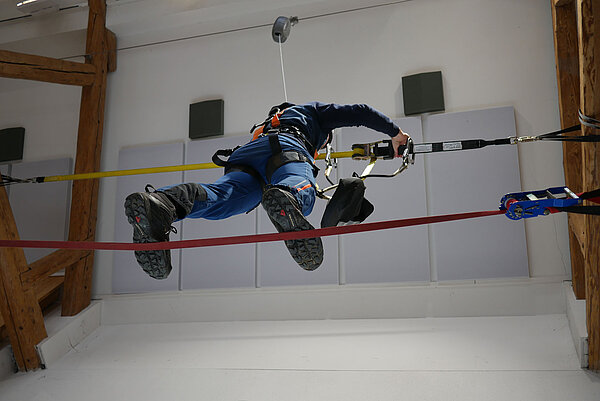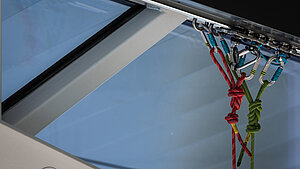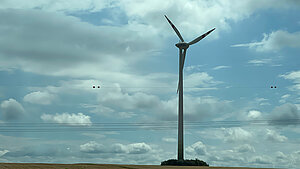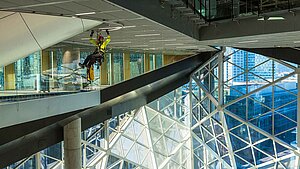Working at height is associated with significant risks, and accidents can have serious consequences. For this reason, standards and regulations were laid down for the protection of employees. EN 795 is such a standard, and it defines the requirements for personal fall protection systems in Europe.
EN 795 plays an important role in ensuring the safety of employees working at height, because it contains guidelines for the design, certification, use, and inspection of the anchorage devices.
Correspondingly, like other standards EN 795 is especially relevant for the manufacturers of fall protection systems. However, understanding this standard is also important, both for employers and employees, in order to comply with regulations and to create a safe work environment.
If you know the EN 795...
...you are able to ensure that you use the correct equipment and comply with the correct guidelines in order to ensure a safe work environment. Furthermore, understanding this standard can help you to make informed decisions about the selection and use of fall protection systems, and so in the end to reduce the risk of accidents and injuries.
The most important contents of EN 795
EN 795 is a European standard which specifies the requirements for the design, installation, use, and servicing of fall protection systems. It applies to all equipment used for preventing falls from a height or for intercepting them.
Particular emphasis is placed on the fixed anchor points and the personal protective equipment (PPE), which consists of lanyard and safety harness. The standard consists of four elements in total:
- Design: This part of the standard specifies the design criteria for the PPE, anchor points, and their components, including the strength requirements and other performance criteria. This section is important to manufacturers of fall protection systems.
- Installation: This section contains information about the correct and safe installation of anchorage devices. It also contains guidelines for inspecting the anchoring systems before they are used. According to industrial protection law, employers are responsible for a safe work environment.
- Selection and use: EN 795 contains detailed instructions for the use of the fall protection systems. These include a risk assessment, as well as information about the type of personal protective equipment to be used, and safety instructions for the users.
- Servicing: This section of the standard describes the requirements for inspection and servicing, plus regular inspection of fall protection systems. It also contains guidelines about recognising signs of wear or damage, and specifies when a system should be replaced.
EN 795 types: Anchorage devices in detail
In addition, EN 795 subdivides fall protection systems into 5 different types, which may be selected depending on application area, specific needs, and load capacity:
Type A anchorage devices: Single anchor point (EAP)
A Type A system consists of one or more single anchor points. This is a permanently mounted device to which personal protective equipment can be attached in order to prevent a fall. The anchor points must be inspected regularly in order to ensure their load capacity.

SINGLE ANCHOR POINTS/POSTS
ANCHOR POINTS
SINGLE ANCHOR POINTS/POSTS from INNOTECH are available in very varied models and designs. Depending on substructure and requirement, it is therefore possible to create an optimum solution. Its purpose is to safely dissipate the loads which occur ...

SINGLE ANCHOR POINT/POSTS SET ITEMS
ANCHOR POINTS
SINGLE ANCHOR POINT/POSTS SET ITEMS from INNOTECH are available in very varied models and designs, and they contain all products necessary for secure fastening to the substructure. Depending on substructure and requirement, it is therefore ...
Type B anchorage devices: Temporary anchor points
These anchor points are specially designed to provide temporary anchorage points for fall protection systems. They are not permanently installed, and they can be moved from one location to another. Temporary anchor points are frequently used in the construction industry, in the roofing trade, and for maintenance.

TEMP LIFELINE SYSTEM
TEMP temporary protection
The TEMP lifeline system from INNOTECH can be used everywhere that a horizontal surface must be temporarily protected against falls. The system can be used on construction sites, as well as for industrial structural developments with very varied ...

EAP-MOBI
EAP-MOBI skylight protection system
The EAP-MOBI skylight fall-through protection system from INNOTECH can be used as fall-through protection, and also as a single anchor point for one person. This enables a person positioned on a skylight to move safely, starting from the ...
Type C anchorage devices: Lifeline systems
Type C of EN 795 relates particularly to cable-based systems. A lifeline system makes it possible for the employees to attach themselves at any height to a mobile anchor point when performing their work activity. Lifeline systems as per EN 795 Type C are used in the construction industry, for industrial climbing, and for rescue deployments. They are most frequently used horizontally.

AIO-LIFELINE-SYSTEM-PASSABLE
All-in-one lifeline system, passable
The AIO LIFELINE SYSTEM PASSABLE is used wherever a horizontal surface must be protected. Regardless whether along roofs, facades, in industry or for photovoltaic systems, it provides optimum protection against falls from a height. Neither ...

AIO-PASSABLE-OVERHEAD-LIFELINE-SYSTEM
All-in-one lifeline system, passable, for overhead use
The AIO PASSABLE OVERHEAD LIFELINE SYSTEM is deployed wherever a horizontal overhead must be protected. Regardless whether along a maintenance walkway or in the area of machine safeguarding, the lifeline system can be relied upon to protect ...
Type D anchorage devices: Rail system
Anchorage devices as per EN 795 Type D are rail systems. They are characterised by a rigid anchorage line and particular strength. The guided but mobile anchorage points allow the workers to change their position as required. The advantage of such a system is that, when appropriately certified, it can be used by multiple people. Uses include indoor and outdoor areas in the manufacturing and transport industries.

TAURUS-HORIZONTAL
Rail system for horizontal use
The TAURUS HORIZONTAL rail system is used wherever movements along a horizontally running pathway need to be protected from a fall risk. Regardless whether along roofs, facades, for overhead use, in industry or in connection with photovoltaic ...

TAURUS-ALLROUND
Rail system for all-round use
The TAURUS ALLROUND rail system combines the application range and benefits of TAURUS HORIZONTAL and VERTICAL in the form of a flowing transition between horizontal and vertical movement. Regardless whether industrial buildings, architecturally ...
Type E anchorage devices: Temporary systems stabilised by their own weight
Anchorage devices classified in EN 795 as Type E are fall protection systems which are not permanently installed, and which are stabilised by their own weight. As a rule, they require the use of structural anchors in order to ensure the required strength. These systems are used both indoors and outdoors. Nets for safety and protection are possible examples.
Questions and answers relating to the EN 795 standard
Question: Are there differences in the application of EN 795 depending on the type of workplace?
Answer: Yes, the application of EN 795 can vary according to the work environment. For example, on construction sites or in industrial plants, the requirements for anchorage devices may be different than in sectors such as wind turbines or telecommunication masts. The standard takes this diversity into account and provides solutions for various scenarios.
Question: Can EN 795 be applied in countries outside Europe?
Answer: Yes, EN 795 is a European standard, but it is also recognised internationally and is applied in many countries worldwide as a guideline for the design and installation of fall protection systems. However, national regulations and standards should be taken into account in order to ensure compliance with local requirements.
Question: What are the differences between EN 795 and EN 361 in terms of personal protective equipment against falls from a height?
Answer: EN 795 concentrates on fall protection systems, while EN 361 defines specific requirements for personal protective equipment against falls from a height, such as harnesses. While EN 795 concentrates on the systems used to prevent falls, EN 361 ensures that the equipment worn by the workers provides the necessary protection.
Question: Where can I obtain fall protection systems compliant with EN 795?
Answer: INNOTECH Absturzsicherungen provides a wide range of EN 795-compliant products for various requirements. You can use our Product Finder to find the product suitable for your application area.
DIN EN 795: German variant of the standard
DIN EN 795 is the German edition of EN 795. It serves as a guideline to anchor points and anchorage devices which are used in Germany. Both EN 795 and DIN EN 795 define the requirements for fall protection systems, in order to ensure the safety of persons working at height. In practice, the differences between the two standards are minimal, because DIN EN 795 reproduces the European requirements in a national context.
Overall, standard EN 795 defines the minimum safety criteria for fall protection systems in Europe. When you understand the requirements of this standard, you are able to ensure that your workplace complies with the safety regulations and that your employees are appropriately protected against fall dangers.
